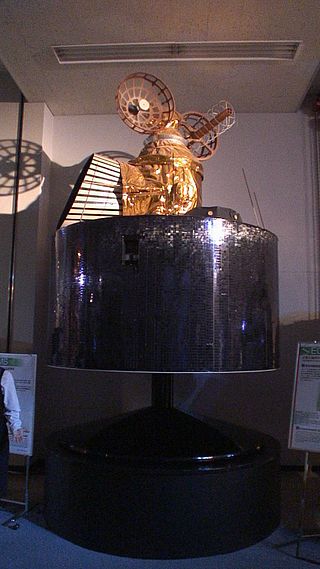
Weather forecasting is the application of science and technology to predict the conditions of the atmosphere for a given location and time. People have attempted to predict the weather informally for millennia and formally since the 19th century.

Tropical cyclones and subtropical cyclones are named by various warning centers to simplify communication between forecasters and the general public regarding forecasts, watches and warnings. The names are intended to reduce confusion in the event of concurrent storms in the same basin. Once storms develop sustained wind speeds of more than 33 knots, names are generally assigned to them from predetermined lists, depending on the basin in which they originate. Some tropical depressions are named in the Western Pacific, while tropical cyclones must contain a significant amount of gale-force winds before they are named in the Southern Hemisphere.

The Bureau of Meteorology is an executive agency of the Australian Government responsible for providing weather services to Australia and surrounding areas. It was established in 1906 under the Meteorology Act, and brought together the state meteorological services that existed before then. The states officially transferred their weather recording responsibilities to the Bureau of Meteorology on 1 January 1908.
GRIB is a concise data format commonly used in meteorology to store historical and forecast weather data. It is standardized by the World Meteorological Organization's Commission for Basic Systems, known under number GRIB FM 92-IX, described in WMO Manual on Codes No.306. Currently there are three versions of GRIB. Version 0 was used to a limited extent by projects such as TOGA, and is no longer in operational use. The first edition is used operationally worldwide by most meteorological centers, for Numerical Weather Prediction output (NWP). A newer generation has been introduced, known as GRIB second edition, and data is slowly changing over to this format. Some of the second-generation GRIB is used for derived products distributed in the Eumetcast of Meteosat Second Generation. Another example is the NAM model.

The National Weather Center (NWC), on the campus of the University of Oklahoma, is a confederation of federal, state, and academic organizations that work together to better understand events that take place in Earth's atmosphere over a wide range of time and space scales. The NWC partners give equal attention to applying that understanding to the development of improved observation, analysis, assimilation, display, and prediction systems. The National Weather Center also has expertise in local and regional climate, numerical modeling, hydrology, and weather radar. Members of the NWC work with a wide range of federal, state, and local government agencies to help reduce loss of life and property to hazardous weather, ensure wise use of water resources, and enhance agricultural production. They also work with private sector partners to develop new applications of weather and regional climate information that provide competitive advantage in the marketplace.
Weatherzone, known before 9 August 2010 as The Weather Company and still trading under this name, is the main provider of value-added meteorological services in Australia. Their main business lines are services to energy, utilities and mining companies. They also provide services to ports, insurance and large retail corporations. They specialize in aggregating content from a large range of private and government funded organisations. Weatherzone is the major commercial weather company that provides meteorological services in Australia.

Integrated Meteorological System, developed by Northrop Grumman is the meteorological component of the Intelligence and Electronic Warfare (IEW), an element of the Army Battle Command System (ABCS). IMETS provides Army commanders at all echelons with an automated weather system to receive, process, and disseminate weather observations, forecasts, and weather and environmental effects decision aids to all Battlefield Operating Systems (BOS). IMETS is designed to be a mobile, tactical, automated weather data receiving, processing and dissemination system. The IMETS is an Army-furnished and maintained system operated by US Air Force battlefield weather team personnel. It uses US Air Force and Army developed software to provide a total weather system to support the Army. The Integrated Weather Effects Decision Aid (IWEDA) software, originally developed by the U.S. Army Research Laboratory (ARL) in 1992, has been fielded on IMETS since 1997 to provide tactical weather support to the U.S. Army.

A Regional Specialized Meteorological Centre (RSMC) is responsible for the distribution of information, advisories, and warnings regarding the specific program they have a part of, agreed by consensus at the World Meteorological Organization as part of the World Weather Watch.

Weather and Society Integrated Studies (WAS*IS) is an international movement that is changing the weather enterprise by integrating social science into meteorological research and practice. WAS*IS was formed to build an interdisciplinary community of practitioners, researchers and decision makers collaborating to effectively understand how to improve weather warnings, incorporate societal impacts into weather forecasts, and use social science tools and methods. WAS*IS is changing the culture from what WAS to what IS the future of integrated studies

The Himawari geostationary satellites, operated by the Japan Meteorological Agency (JMA), support weather forecasting, tropical cyclone tracking, and meteorology research. Most meteorological agencies in East Asia, Southeast Asia, Australia and New Zealand use the satellites for their own weather monitoring and forecasting operations.
McIDAS, the "Man computer Interactive Data Access System", is a weather forecasting tool developed at the University of Wisconsin–Madison in the 1970s and used continually to this day. In its early incarnations, it was widely used to generate graphics for television stations, but today is used primarily by the NOAA and related agencies. Users of the McIDAS system developed a similar version for microcomputers and sold by ColorGraphics Weather Systems that generated much of the computerized weather imagery seen on television in the US in the 1980s.

The 2009–10 Australian region cyclone season was a below average tropical cyclone season, with eight tropical cyclones forming compared to an average of 12. The season began on 1 November 2009 and ran through until it end on 30 April 2010. The Australian region is defined as being to south of the equator, between the 90th meridian east and 160th meridian east. Tropical cyclones in this area are monitored by five Tropical Cyclone Warning Centres (TCWC's): Jakarta, Port Moresby, Perth, Darwin, and Brisbane, each of which have the power to name a tropical cyclone. The TCWC's in Perth, Darwin, and Brisbane are run by the Australian Bureau of Meteorology, who designate significant tropical lows with a number and the U suffix. The Joint Typhoon Warning Center also issues unofficial warnings for the region, designating significant tropical cyclones with the "S" suffix when they form west of 135°E, and the "P" suffix when they form east of 135°E.

The 2019–20 Australian region cyclone season was a below average tropical cyclone season for the waters surrounding Australia between longitudes 90°E and 160°E. The season officially began on 1 November 2019 and ended on 30 April 2020; however, tropical cyclones can form at any time of year, as evidenced by Tropical Cyclone Mangga during May 2020. As such, any system existing between 1 July 2019 and 30 June 2020 would count towards the season total. The season featured the region's second-latest start on record, with the formation of the first tropical low only occurring on 4 January 2020. A total of eight tropical cyclones formed during the season, which represents the region's least active season since the 2016–17 season. Three systems intensified further into severe tropical cyclones, and three systems made landfall within the region at tropical cyclone intensity. A total of 28 fatalities were caused, either directly or indirectly, as a result of impacts from the season's systems. Cyclone Ferdinand was the strongest of the season reaching Category 4 in late February 2020. However, it was the second-strongest storm, Cyclone Damien, that was the most damaging. Damien was the strongest tropical cyclone to strike Western Australia's Pilbara Region since Cyclone Christine in 2013, making landfall directly over the town of Dampier.
The Navy Global Environmental Model (NAVGEM) is a global numerical weather prediction computer simulation run by the United States Navy's Fleet Numerical Meteorology and Oceanography Center. This mathematical model is run four times a day and produces weather forecasts. Along with the NWS's Global Forecast System, which runs out to 16 days, the ECMWF's Integrated Forecast System (IFS) and the CMC's Global Environmental Multiscale Model (GEM), both of which run out 10 days, and the UK Met Office's Unified Model, which runs out to 7 days, it is one of five synoptic scale medium-range models in general use.

The Automated Tropical Cyclone Forecasting System (ATCF) is a piece of software originally developed to run on a personal computer for the Joint Typhoon Warning Center (JTWC) in 1988, and the National Hurricane Center (NHC) in 1990. ATCF remains the main piece of forecasting software used for the United States Government, including the JTWC, NHC, and Central Pacific Hurricane Center. Other tropical cyclone centers in Australia and Canada developed similar software in the 1990s. The data files with ATCF lie within three decks, known as the a-, b-, and f-decks. The a-decks include forecast information, the b-decks contain a history of center fixes at synoptic hours, and the f-decks include the various fixes made by various analysis center at various times. In the years since its introduction, it has been adapted to Unix and Linux platforms.
The Hybrid Single-Particle Lagrangian Integrated Trajectory model (HYSPLIT) is a computer model that is used to compute air parcel trajectories to determine how far and in what direction a parcel of air, and subsequently air pollutants, will travel. HYSPLIT is also capable of calculating air pollutant dispersion, chemical transformation, and deposition. The HYSPLIT model was developed by the National Oceanic and Atmospheric Administration (NOAA) Air Resources Laboratory and the Australian Bureau of Meteorology Research Centere in 1998. The model derives its name from the usage of both Lagrangian and Eulerian approaches.

Severe Tropical Cyclone Amos was a strong tropical cyclone that affected the Fijian and Samoan Islands as well as Wallis and Futuna. Amos was first noted as Tropical Disturbance 17F during April 13, 2016 to the northwest of Fiji. The system subsequently moved south-eastwards towards the Fijian Islands, before it passed near or over Vanua Levu during April 16. After passing over Fiji, the system gradually developed further as it moved north-eastwards towards the Samoan Islands. The system was subsequently named Amos during April 20, after it had developed into a tropical cyclone and started to move north-westwards towards the island nation of Tuvalu.
SILAM is a global-to-meso-scale atmospheric dispersion model developed by the Finnish Meteorological Institute (FMI). It provides information on atmospheric composition, air quality, and wildfire smoke (PM2.5) and is also able to solve the inverse dispersion problem. It can take data from a variety of sources, including natural ones such as sea salt, blown dust, and pollen.










